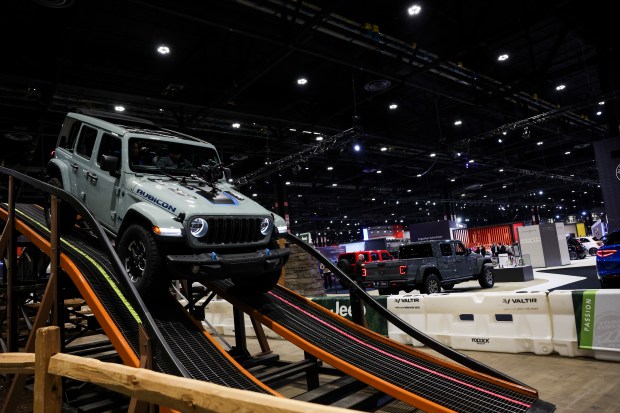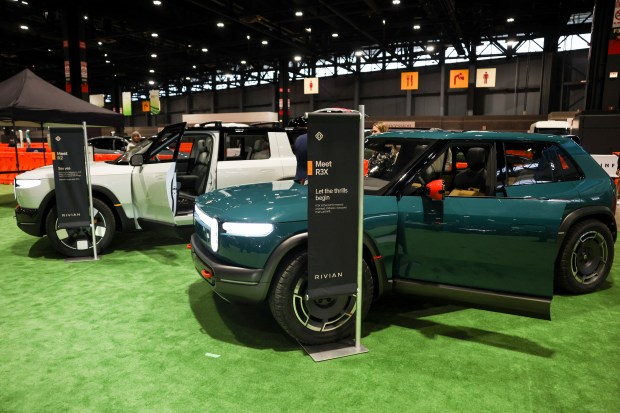The atmosphere is electric at this year’s Chicago Auto Show, with two indoor EV test tracks, dozens of models and several high-profile debuts, including the first appearance by homegrown Rivian.
But with EV sales growth slowing and threats by President Donald Trump to impose tariffs, pause infrastructure build-out and end federal tax credits, an air of uncertainty hangs over the 117th edition of North America’s largest auto show, which opens Saturday at McCormick Place.
“I think 2025 is more uncertain than it was a couple of weeks ago, and it was already pretty uncertain in terms of where the EV market is going,” said David Greene, an analyst with Cars.com.
Automakers are all in on EVs this year, with display after display featuring sleek electric vehicles, charging stations and sales placards touting range. Beyond the EV-curious, there are plenty of other attractions to lure attendees to this year’s show, from a sleek 1,001-horsepower hybrid Lamborghini supercar to the return of the popular Camp Jeep test track after a one-year hiatus.
There’s even a chance to take another wheel for a spin by auditioning for ABC’s “Wheel of Fortune” on Saturday and Sunday.
But if electric vehicles are indeed the future of the auto industry, then the future is now at the Chicago Auto Show, which added a second EV test track to accommodate a slew of rides from a dozen automakers, including the new Jeep Wagoneer S and Dodge Daytona Charger — the first all-electric vehicles offered by the Stellantis-owned brands.
Stellantis skipped last year’s show, pulling its Jeep, Chrysler, Dodge, Fiat and Ram vehicles off the floor and ending the two-decade run of Camp Jeep.
Newcomer Rivian, which launched production in a former Mitsubishi factory in downstate Normal in September 2021, is making its first Chicago Auto Show appearance to introduce its second-generation EVs — the downsized R2 and R3X SUVs, which are slated to begin rolling off the production line beginning in 2026.
Rivian will also offer rides in its R1S SUV, R1T truck and its commercial van at the EV test tracks, which are sponsored by ComEd.
The R2 and R3X will be on display, but remain parked next to the track, giving attendees a first look at what’s coming down the road. Rivian is seeking to lure new buyers at price points well below its first-generation SUV and truck, which cost upward of $80,000, making them ineligible for the $7,500 federal tax credit. The R2 will be priced starting at $45,000.
“As you hit a more mainstream market … you’re talking to a much wider set of audiences,” Mikhael Farah, director of product communications at Rivian, said Thursday during a media preview. “As we talk to more people, it’s good to be at more shows that focus on getting customers into the vehicle to feel it, experience it, and see what an EV can do.”
The Rivian commercial van has a narrower target audience. A slight variation of the Amazon electric delivery vans out delivering packages in Chicago and other markets, Rivian will begin selling the generic version to commercial customers this month. The price starts at $79,900 and qualifies for a $7,500 IRS commercial credit. Potential buyers range from delivery services to local contractors.
A ride around the test track showed the boxy Rivian van holding its own surprisingly well with sportier consumer EVs. Rivian employs a software-controlled top speed limit of 70 mph, ostensibly to keep packages from getting jostled or drivers from tapping their inner “Fast & Furious” while making deliveries.
While growth has slowed, EV sales hit a record 1.3 million units last year, accounting for 8.1% of total auto sales in the U.S., according to Cox Automotive’s Kelley Blue Book. Tesla remains the top selling EV brand, although it showed the largest year-over-year volume decline of any manufacturer as legacy automakers increase their offerings and continue to gain traction.
Total new vehicle sales reached nearly 16 million in 2024, according to Cox.
With 15 new products scheduled to hit the market, Cox projects EV sales to reach nearly 10% of total new vehicle sales in 2025, despite policy changes in Washington that might slow adoption in the longer term. Other industry analysts are less bullish on the short-term prospects for EVs under Trump 2.0.
Last month, Trump issued an executive order seeking to “eliminate the electric vehicle mandate,” threatening everything from the $7,500 federal tax credit to the charging infrastructure build-out. Trump also revoked former President Joe Biden’s 2021 executive order setting the target that EVs make up half of all new vehicles sold by 2030.
Greene said it may take more than an executive order to “turn off” the $7,500 tax credit, part of Biden’s sweeping Inflation Reduction Act of 2022. At the same time, tightening restrictions including price, income and battery component requirements are reducing the number of EVs that qualify for the tax credit.
Leasing an EV, however, provides a commercial credit loophole that increases the ability to qualify for the federal tax credit. Greene said that 7 out of 10 EVs that hit the road in December were leased — a far greater lease-to-sale ratio than for gas-powered vehicles.
A more imminent threat to many new car buyers may be tariffs. On Feb. 1, Trump announced 25% tariffs on imports from Canada and Mexico before offering a one-month reprieve days later.
Last year, 3.6 million vehicles were imported from Canada and Mexico — including many assembled at Big Three-owned plants — representing more than a fifth of all vehicles sold in the U.S., according to a report from S&P Global Mobility. A 25% tariff could add up to $6,250 to the price of a $25,000 vehicle. In addition, if components and parts are included in the 25% tariffs, it would raise the price of “most vehicles produced in the U.S.,” the report found.
While both the new Jeep Wagoneer S and Dodge Daytona Charger EVs qualify for federal tax credits through purchase or lease, the Jeep is made in Mexico and the Dodge is built in Canada, according to Kelley Enright, a Stellantis spokesperson.

“Right now, those federal incentives are offered and we urge consumers to go out to the dealerships,” Enright said Thursday, declining to comment on the potential impact of tariffs.
The looming tariff and tax credit threats may provide a catalyst to accelerate new car purchases, especially for EV buyers, Greene said.
One place EV buyers might visit at the show is the ComEd booth. The utility announced Thursday it is offering $100 million in rebates this year to help fund EV adoption, including $9 million for home charging systems, $53 million for EV fleet purchases and $38 million for infrastructure charging projects.
More than 50% of the funds are reserved for low-income and equity communities through the beneficial electrification plan, the utility said.
A requirement under the state’s Climate and Equitable Jobs Act, ComEd committed $231 million over three years to help customers transition to EVs. In 2024, ComEd helped fund 3,500 charging ports and 200 electric fleet vehicles, according to Cristina Botero, senior manager of the program.
This year, ComEd is offering up to $3,750 for low-income customers and up to $1,000 for other residential customers to defray the cost of home chargers. Last year the rebate for residential customers was $2,500, but the program ran out of money in July, Botero said.
“We lowered it to be able to spread across more customers since it went so quickly,” Botero said.
Stellantis, which recommitted last month to build a midsize pickup truck at the shuttered Belvidere Assembly Plant near Rockford, is bringing back its full brand portfolio and Camp Jeep, where professional drivers take passengers on an indoor off-road course, tackling a 28-foot, 40-degree hill climb.
The road ahead may be equally challenging for the auto industry — particularly the EV segment — in 2025.
“We’re going to find out what natural demand truly is, especially if any of the heavy incentives go away,” Greene said.
The auto show runs through Feb. 17.




